Fifth generation of video game consoles
  |
| Part of a series on the |
| history of video games |
|---|
The fifth-generation era (also known as the 32-bit era, the 64-bit era and the 3D era) refers to computer and video games, video game consoles and video game handhelds from approximately 1993 to 2001. For home consoles, the best-selling console was the PlayStation by a wide margin, followed by the Nintendo 64 and then the Sega Saturn. For handhelds, this era was characterized by significant fragmentation, because the first handheld of the generation, the Genesis Nomad, had a lifespan of just two years, and the Virtual Boy had a lifespan of less than one. Both were discontinued before the other handhelds made their debut. The Neo Geo Pocket was released in 1998, but was dropped by SNK in favor of the fully backwards compatible Neo Geo Pocket Color just a year later. Nintendo's Game Boy Color was the winner in handhelds by a large margin. There were also two updated versions of the original Game Boy: Game Boy Light (Japan only) and Game Boy Pocket.
The era is known for its pivotal role in the video game industry's leap from 2D computer graphics to 3D computer graphics, as well as the shift from home consoles using ROM cartridges to optical discs. The development of the Internet also made it possible to store and download tape and ROM images of older games, eventually leading 7th generation consoles (such as the Xbox 360, Wii, PlayStation 3, PlayStation Portable, and Nintendo DSi) to make many older games available for purchase or download. There was considerable overlap between this and the sixth generation of consoles, which began with the launch of the Dreamcast in Japan on November 27, 1998. The fifth generation officially ended with the discontinuation of the PlayStation (known in its re-engineered form as the "PSOne") in March 2006, a few months after the launch of the seventh generation.
Some features that distinguished fifth generation consoles from fourth generation consoles include:
- 3D polygon graphics with texture mapping
- Optical disc (CD-ROM) game storage, allowing much larger storage space (up to 650 MB) than ROM cartridges
- CD quality audio recordings (music and speech), PCM audio with 16-bit depth and 44.1 kHz sampling rate
- Wide adoption of full motion video, displaying pre-rendered computer animation or live action footage
- Analog controllers
- Display resolution from 480i to 576i
- Color depth up to 16,777,216 colors (24-bit true color)
- 3D graphical capabilities such as lighting, Gouraud shading, anti-aliasing and texture filtering
History
Transition to 3D
The 32-bit/64-bit era is most noted for the rise of fully 3D polygon games. While there were games prior that had used three-dimensional polygon environments, such as Virtua Racing and Virtua Fighter in the arcades and Star Fox on the Super NES, it was in this era that many game designers began to move traditionally 2D and pseudo-3D genres into 3D on video game consoles. Early efforts from then-industry leaders Sega and Nintendo saw the introduction of the 32X and Super FX, which provided rudimentary 3D capabilities to the 16-bit Genesis and Super NES. Prime examples of this trend include Virtua Fighter 2 on the Saturn, Tomb Raider on the PlayStation and Saturn, Tekken and Crash Bandicoot on the PlayStation, and Super Mario 64 on the N64. Their 3D environments were widely marketed and they steered the industry's focus away from side-scrolling and rail-style titles, as well as opening doors to more complex games and genres. 3D became the main focus in this era as well as a slow decline of cartridges in favor of CDs, due to the ability to produce games less expensively and the media's high storage capabilities.
CD vs. cartridge
After allowing Sony to develop a CD-based prototype console for them and a similar failed partnership with Philips,[1] Nintendo decided to make the Nintendo 64 a cartridge-based system like its predecessors. Publicly, Nintendo defended this decision on the grounds that it would give games shorter load times than a compact disc (and would decrease piracy). However, it also had the dubious benefit of allowing Nintendo to charge higher licensing fees, as cartridge production was considerably more expensive than CD production. Many third-party developers like EA Sports viewed this as an underhanded attempt to raise more money for Nintendo and many of them became more reluctant to release games on the N64.
Nintendo's decision to use a cartridge based system sparked a small scale war amongst gamers as to which was better. The chief advantages of the CD-ROM format were (1)larger storage capacity, allowing for a much greater amount of game content, and (2)considerably lower manufacturing costs, making them considerably more profitable for game publishers. Its disadvantages compared to cartridge were (1)considerable load times, (2)their inability to load data "on the fly", making them reliant on the console RAM, and (3)the greater manufacturing costs of CD-ROM drives compared to cartridge slots, resulting in generally higher retail prices for CD-based consoles.[2] A Nintendo magazine ad placed a Space Shuttle (cartridge) next to a snail (a CD) and dared consumers to decide "which one was better".
Almost every other contemporary system used the new CD-ROM technology (the Nintendo 64 was the last major home video game console to use cartridges). Consequent to the storage and cost advantages of the CD-ROM format, many game developers shifted their support away from the Nintendo 64 to the PlayStation. One of the most influential game franchises to change consoles during this era was the Final Fantasy series, beginning with Final Fantasy VII, which was originally being developed for the N64 but due to storage capacity issues was shifted to and released on the PlayStation;[3] prior Final Fantasy games had all been published on Nintendo consoles – either the NES or Super NES, with the only other entries being on the Wonderswan, or computers like the MSX.
Overview of the fifth generation consoles
There was much confusion over which console was superior to the others. Adding to the uncertainty was the fact that there were more competing consoles in this era than at any other time since the North American video game crash of 1983, with video game magazines frequently predicting a second crash due to the similar deluge of new consoles.[4] Also, console makers routinely boasted theoretical maximum limits of each system's 3D polygon rendering without accounting for real world in-game performance.
The FM Towns Marty is considered the world's first 32-bit console (predating the Amiga CD32 and 3DO), being released in February 20, 1993 by Japanese electronic company Fujitsu. Never released outside Japan, it was largely marketed as a console version of the FM Towns home computer, being compatible with games developed for the FM Towns. It failed to make an impact in the marketplace due to its expense relative to other consoles and inability to compete with home computers.[5] While using a 32-bit word length, however, the Intel 80386SX CPU only supports 16-bit bus addressing (similar to the Motorola 68000 in 1985's Amiga 1000) and a maximum of 24-bit RAM addressing.
Despite massive third party support and an unprecedented amount of hype for a first-time entrant into the industry, the 3DO Interactive Multiplayer's $700 price tag hindered its success.
The Amiga CD32 was sold in Europe, Australia, Canada and Brazil, but never in the United States due to Commodore's bankruptcy.[6]
The 32X, an add-on console for the Genesis, was launched a short time before the Sega Saturn. The Sega Neptune was also announced as a standalone version of the 32X, but ultimately canceled. Sega failed to deliver a steady flow of games for the 32X platform. More importantly, with the Saturn and PlayStation already on the horizon, most gamers preferred to save up their money rather than spend it on a console that was doomed to become obsolete in just a few months.[7]
The Sega Saturn was released as Sega's entry into the 32-bit console market.[1] It became Sega's most successful console in Japan, but it was not the overseas commercial success that the Master System and Mega Drive had been and lagged in third place overall.
The Atari Jaguar was released in 1993 as the world's first 64-bit system. However, sales at launch were well below the incumbent fourth generation consoles, and a small games library rooted in a shortage of third party support made it impossible for the Jaguar to catch up, selling below 300,000 units. The system's 64-bit nature was also questioned by many. The 32-bit Atari Panther, set to be released in 1991, was canceled due to unexpectedly rapid progress in developing the Jaguar.[8]
The Atari Jaguar CD, an add-on console for the Jaguar, was released in 1995. It was produced in limited quantities due to the low install base of the system.
The PlayStation was the most successful console of this generation, with attention given by 3rd party developers enabling it to achieve market dominance, becoming the first home console to ship 100 million units worldwide.
Because of many delays in the release of the Nintendo 64, in 1995 Nintendo released the Virtual Boy, a supposedly portable system capable of displaying true 3D graphics, albeit in monochromatic red and black. However, in practice it is not functionally portable, though it was at first marketed as such, and because of the nature of its graphical capabilities, the system can cause headaches and eye strain. It was discontinued within a year, with less than 25 games ever released for it.
The Nintendo 64, originally announced as the "Ultra 64", was released in 1996. The system's delays and use of the cartridge format while all of its competitors used CDs made it an unpopular platform among third party developers. However, a number of wildly popular 1st party titles allowed the Nintendo 64 to maintain strong sales in the United States, though it still remained a distant second to the PlayStation.
NEC, creator of the TurboGrafx-16, TurboDuo, Coregrafx, and SuperGrafx, also entered the market with the PC-FX in 1994. The system had a 32-bit processor, 16-bit stereo sound, a 16,777,000 color palette and featured the highest quality full motion video of any console on the market at the time. The PC-FX broke away from traditional console design by being a tower system that allowed for numerous expansion points including a connection for NEC's PC-9800 series of computers. Despite its impressive specs, it was marketed as the ultimate side-scrolling console and could not match the sales of the 3D systems currently on the market.
Results of the fifth generation
By the end of the 1995 Christmas shopping season, the fifth generation has come down to a struggle between the Sony PlayStation, Sega Saturn, 3DO Interactive Multiplayer, and the upcoming Nintendo 64. The FM Towns Marty and Amiga CD32 had already been discontinued; the Jaguar and 32X were still on the market but were considered a lost cause by industry analysts; the Neo Geo CD had proven to appeal only to a niche market; and industry analysts had already determined that the yet-to-launch Apple Bandai Pippin was too expensive to make any impact in the market.[9] Moreover, even the leading fifth generation consoles were still facing sluggish sales. Combined sales for the PlayStation, Saturn, and 3DO barely topped 1 million units for the Christmas shopping season, as compared to combined sales of 4 million for the Sega Genesis and Super NES.[10] Industry analysts began putting forth the possibility that the fifth generation of consoles would never overtake the fourth generation in sales, and become superseded by a new generation of DVD player consoles before they could achieve mass acceptance.[11]
After the dust settled in the fifth generation console wars, several companies saw their outlooks change drastically. Atari Corporation, which was not able to recover its losses, ended up being purchased by JT Storage and stopped making game hardware. Sega's loss of consumer confidence (coupled with its previous console failures) along with their financial difficulties, set the company up for a similar fate in the next round of console wars.
The Sega Saturn suffered from poor marketing and comparatively limited third-party support outside Japan.[1] Sega's decision to use dual processors was roundly criticized, as this made it difficult to efficiently develop for the console. Sega was also hurt by a surprise four-month-early U.S. launch of their console. Third party developers, who had been planning for the originally scheduled launch, could not provide launch titles and were angered by the move. Retailers were caught unprepared, resulting in distribution problems. Some retailers, such as the now defunct KB Toys, were so furious that they refused to stock the Saturn thereafter.[12]
Due to numerous delays, the Nintendo 64 was released one year later than its competitors. By the time it was finally launched in 1996, Sony had already established its dominance, the Saturn was starting to struggle, and the Jaguar and 3DO had been discontinued. Its use of cartridge media rather than compact discs alienated some developers and publishers due to the space limits, the relatively high cost involved, and a considerably longer production time. In addition, the initially high suggested retail price of the console may have driven potential customers away, and some early adopters of the system who had paid the initial cost may have been angered by Nintendo's decision to reduce the cost of the system US$50 six months after its release. However, the Nintendo 64 was popular in North America, mostly the U.S, selling 20.63 million units in the region (more than half of its worldwide sales of 32.93 million units), and is home to highly successful games such as The Legend of Zelda: Ocarina of Time, Super Mario 64, GoldenEye 007, Banjo-Kazooie, and Super Smash Bros.. Still, while the Nintendo 64 sold far more units than the Sega Saturn, Atari Jaguar, and 3DO, it failed to surpass the PlayStation, which dominated the market.
By 1997, 40% to 60% of American homes played on video game consoles. 30% to 40% of these homes owned a console, while an additional 10% to 20% rented or shared a console.[13]
Home systems
Technical Comparison[14]
| Name | 3DO Interactive Multiplayer | Atari Jaguar | Sega Saturn | PlayStation | Nintendo 64 |
|---|---|---|---|---|---|
| Manufacturer | Panasonic, Sanyo, GoldStar | Atari | Sega | Sony (SCE) | Nintendo |
| Console |  |
 |
 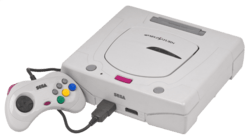 |
  |
 |
| Launch price (USD) | US$699.99 (equivalent to $1,149 in 2015) | US$249.99 (equivalent to $410 in 2015) | US$399.99 (equivalent to $622 in 2015) | US$299.99 (equivalent to $467 in 2015)[15] | US$199.99 (equivalent to $302 in 2015) |
| Release date | |||||
| Media | CD-ROM | Cartridge, CD-ROM (via add-on) |
|
CD-ROM |
|
| Best-selling game | Gex, over 1 million[16][17] | Unknown | Virtua Fighter 2, 1.7 million in Japan[18] | Gran Turismo, 10.85 million shipped (as of April 30, 2008)[19][20] | Super Mario 64, 11.62 million (as of May 21, 2003)[21][22] |
| CPU | ARM60 (32‑bit RISC) @ 12.5 MHz (10 MIPS) |
|
LSI LR333x0 (R3000A compatible 32‑bit RISC) @ 33.8688 MHz (30 MIPS) | NEC VR4300 (64‑bit RISC) @ 93.75 MHz (125 MIPS)[27] | |
| GPU | 2× accelerated video co-processors |
|
Reality Co-Processor (64‑bit MIPS R4000 based, 128‑bit vector register processor) @ 62.5 MHz | ||
| Sound chip(s) | Custom 20‑bit DSP | "Jerry" chip: DSP, 2× DAC (converts digital data to analog signals) |
|
Sony SPU (Sound Processing Unit) | Reality Signal Processor (DSP) |
| Memory | 3 MB RAM | 2 MB FPM DRAM (4× 512 KB chips) | 4.5 MB RAM
|
3587 KB RAM
|
4 MB RDRAM (8 MB with Expansion Pak) |
| Video |
|
|
|
|
|
| Audio | Stereo audio, with:
|
Stereo audio, with:
|
Stereo audio, with:[32]
|
Stereo audio, with:
|
Stereo audio, with: |
| Accessories (retail) |
|
|
|
|
|
| Online services | None | Using 19.9k voice dialling (1995-?) | Online multiplayer and web browsing using NetLink in North America (1996-present), and through SegaNet in Japan (1996-2000) | None | Unofficial SharkWire Online in the U.S. (1999-2003), Randnet in Japan for 64DD (1999-2001) |
Other consoles
- Mass market
These consoles were created for the mass market, like the 5 consoles listed above. These, however, are less notable, never saw a worldwide release, and/or have sold particularly poorly, and are therefore listed as 'Other'.
 FM Towns Marty, created by Fujitsu. Released on February 20, 1993.
FM Towns Marty, created by Fujitsu. Released on February 20, 1993.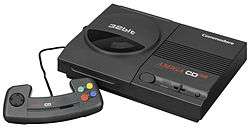 Amiga CD32, created by Commodore. Released on September 17, 1993.
Amiga CD32, created by Commodore. Released on September 17, 1993. CPS Changer, created by Capcom. Released in 1994.
CPS Changer, created by Capcom. Released in 1994.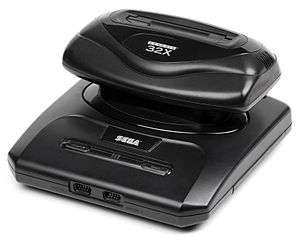


- Non-mass-market systems

 Casio Loopy, created by Casio. Released in October 1995 in Japan, targeted at female gamers.
Casio Loopy, created by Casio. Released in October 1995 in Japan, targeted at female gamers.
Add-ons and remakes

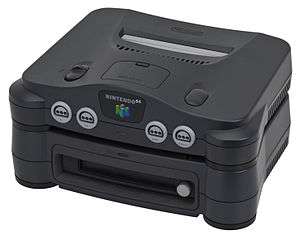 Nintendo 64DD
Nintendo 64DD
Released in Japan in 1999
Worldwide sales standings
| Console | Units sold |
|---|---|
| PlayStation | 102.49 million shipped (74.34 million PlayStation, 28.15 million PSone) (as of March 31, 2005)[49] |
| Nintendo 64 | 32.93 million (as of March 31, 2005)[50] |
| Sega Saturn | 9.26 million |
| 3DO | — |
| Atari Jaguar | 250,000 (as of May 15, 2007)[51] |
| Amiga CD32 | 100,000 |
| PC-FX | <100,000 |
| FM Towns Marty | 45,000 (as of December 31, 1993) |
| Apple Bandai Pippin | 42,000 (as of May 4, 2007)[52] |
From 1996 to 1999 (when the PlayStation, N64 and Saturn were the major 5th-generation consoles still on the market) Sony managed a 47% market share of the worldwide market, followed by Nintendo with 28% (with a percentage of that figure from the 16‑bit Super NES), while Sega was third with 23% (with a percentage of that from the Dreamcast).[53]
Production of the Sega Saturn was discontinued in 1998. Its demise being accelerated by rumors that work on its successor was underway; these rumors hurt the systems' sales in the west as early as 1997. The N64 was succeeded by the GameCube in 2001, but continued its production until 2004; however, PlayStation production was not ceased as it was redesigned as the PSone, further extending the life of the console around the release of the follow-up PlayStation 2. The PlayStation console production was discontinued in 2006, shortly after the Xbox 360 was released.
Handheld systems

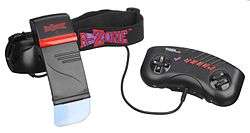 R-Zone
R-Zone
Released in 1995
 Game.com
Game.com
Released in 1997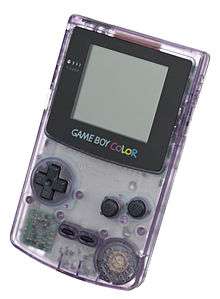
 Neo Geo Pocket
Neo Geo Pocket
Released in 1998 Pocketstation (1999) Released in Japan only
Pocketstation (1999) Released in Japan only WonderSwan (1999) Released in Japan only
WonderSwan (1999) Released in Japan only WonderSwan Color (2000) Released in Japan only
WonderSwan Color (2000) Released in Japan only
Software
Milestone titles
- Castlevania: Symphony of the Night (PlayStation, Saturn) by Konami Computer Entertainment Tokyo and Konami is considered one of the best PlayStation games available, and a strong argument for the relevance of 2D games in an increasingly 3D market.[56][57][58]
- Crash Bandicoot (PlayStation) by Naughty Dog and Sony Computer Entertainment (SCE) would go on to become Sony's unofficial mascot in contrast with Nintendo's Mario and Sega's Sonic the Hedgehog. The game featured a marsupial bandicoot named Crash and would prove to be one of the PlayStation's most successful titles.
- Dragon Warrior VII (PlayStation) by Heartbeat, ArtePiazza, and Enix was the number one best-selling title on the PlayStation in Japan, released in 2000. The game was the first main installment of Japan's national RPG series released in 5 years.
- FIFA International Soccer (3DO) by EA Sports and Electronic Arts has been described as one of the most influential sports games ever made.[59]
- Final Fantasy VII (PlayStation) by Square Product Development Division 1 and Squaresoft, is one of the PlayStation's most popular titles. It was the first game in the Final Fantasy series to make use of full motion videos (FMVs) and opened the door to the mainstream US market for Japanese-origin RPGs by SquareSoft. Final Fantasy became one of the biggest franchises in video gaming, with FFVII in particular having several spin-offs known as Compilation of Final Fantasy VII, including two sequels (a movie, and an action adventure game) and a prequel.
- GoldenEye 007 (Nintendo 64) by Rare Ltd. and Nintendo is a critically acclaimed game that helped make the first-person shooter a potential popular genre on consoles.
- Gran Turismo (PlayStation) by Polyphony Digital and SCE broke away from the mold of traditional arcade style racing games by offering realistic physics and handling as well as a plethora of licensed vehicles.
- The Legend of Zelda: Ocarina of Time (Nintendo 64) by Nintendo EAD and Nintendo is one of the most critically acclaimed games of all time and often listed as one of the greatest video games of all time.[58][60][61][62][63][64][65] It transferred the playing mechanics of the previous 2D Zelda adventures to a 3D environment, with a 3rd person perspective that could switch to 1st person view. It also featured mini-games, such as fishing and horseback riding, and gave birth to the Z targeting system, which would become a mainstay in the series battles.
- Metal Gear Solid (PlayStation) by Konami Computer Entertainment Japan and Konami received critical acclaim for its involved storyline, believable voice acting, and cinematic presentation, and is considered one of the best games of all time. The series remains a best seller for the PlayStation along with the series branching off to Xbox and other Nintendo consoles after many successes.
- The Need for Speed (3DO, PlayStation, Saturn) by Pioneer Productions and Electronic Arts shot well ahead of prior racing simulators in graphics and realism, and spawned a number of sequels.
- Nights into Dreams... (Saturn) by Sonic Team and Sega was bundled with the Saturn's analog controller, which was almost essential to the gameplay. With its innovative gameplay and graphics, Nights, an exclusive title, aided in the selling of a number of Saturns.
- Panzer Dragoon Saga (Saturn) by Team Andromeda and Sega is the highest-rated Saturn title on Game Rankings with a score of 92.87%,[66] and has been cited as one of the greatest games ever made.[58][67][68]
- Perfect Dark (Nintendo 64) by Rare Ltd. and Nintendo was critically acclaimed, building on what made GoldenEye 007 successful: making use of the Nintendo 64 expansion pack. It received a 97/100 from Metacritic.[69]
- Resident Evil (PlayStation, Saturn) by Capcom and Silent Hill (PlayStation) by Konami Computer Entertainment Tokyo and Konami helped popularize the survival horror genre on consoles. This genre continued to grow in the sixth generation of video games, and Silent Hill and Resident Evil went on to produce many successful sequels. Both have since been adapted for films.
- Sega Rally Championship (Arcade, Saturn) by Sega AM5 and Sega was the first rally racing game,[70] broke new ground by incorporating different surfaces with different friction properties,[71][72] and has been cited as one of the greatest racing games ever made.[71][73]
- Star Fox 64 (Nintendo 64) by Nintendo EAD and Nintendo is the first Nintendo 64 game to use the Nintendo 64 Rumble Pak, which bundled with the game. It was a success and sold 3 million copies worldwide.
- Super Mario 64 (Nintendo 64) by Nintendo Entertainment Analysis & Development (Nintendo EAD) and Nintendo is considered to be one of the greatest games of all time, particularly for its use of a dynamic camera system, the implementation of its 360-degree analog control, and open world design.[74] Super Mario 64 is one of the best selling home console games of the era, selling 11.62 million copies worldwide.
- Super Smash Bros. (Nintendo 64) was a breakthrough IP for Nintendo, featuring characters from Nintendo owned franchises fighting in a party styled game. Super Smash Bros. has since been succeeded by 4 additional titles in the series.
- Tekken 3 (PlayStation) is considered not only to be the greatest installment of the Tekken series, but remains as one of the greatest fighting games of all time according to PlayStation Magazine.[75] It has a Metacritic score of 96, and is the 12th highest rated game ever according to GameRankings.[76] Its predecessor achieved similar feats until its succession,[77] and the first game in the franchise was the first PlayStation game to sell over a million units.[78]
- Tomb Raider (PlayStation, Saturn) by Core Design and Eidos Interactive popularized many elements seen in later video games and spawned several very successful sequels. The main character, Lara Croft, was named the most recognizable female video game character by Guinness World Records.[79]
- Tony Hawk's Pro Skater 2 (Nintendo 64, PlayStation) by Neversoft and Activision garnered widespread critical acclaim and has been cited as one of the greatest games ever made.[58]
- Virtua Cop (Arcade, Saturn) by Sega AM2 and Sega introduced the use of 3D polygons to the light-gun shooter genre,[80] paving the way for future light gun shooters like Namco's Time Crisis and Sega's The House of the Dead, and was a major influence on GoldenEye 007.[81]
- Virtua Fighter (Arcade, Saturn) by Sega AM2 and Sega created the 3D fighting game genre.[82] The console port, which was nearly identical to the arcade game, sold at a nearly 1:1 ratio with the Saturn hardware at launch.[83] The original arcade version also had a major influence on the PlayStation becoming a 3D focused console.[84]
See also
- Sixth generation of video game consoles
- Fourth generation of video game consoles
- Commodore International
- The 3DO Company
- Playdia
References
- 1 2 3 Christopher Dring, 2013-07-11, A Tale of Two E3s - Xbox vs Sony vs Sega, MCV
- ↑ "The Format of the Future: CD-ROM or Cartridge?". GamePro (59). IDG. June 1994. p. 8.
- ↑ "Squaresoft Head for Sony". Maximum: The Video Game Magazine. Emap International Limited (4): 105. March 1996.
- ↑ Carpenter, Danyon (July 1994). "The Flood Waters Are Rising...". Electronic Gaming Monthly (60). EGM Media, LLC. p. 6.
- ↑ "FM Towns Marty/FM Towns Marty 2 Console Information". Consoledatabase.com. Archived from the original on May 7, 2005. Retrieved August 17, 2009.
- ↑ Perelman, M: "Steal This Idea", page 60. Palgrave Macmillan, 2004
- ↑ "32X/Project Mars: Anatomy of a Failure". goodcowfilms.com. Retrieved June 22, 2007.
- ↑ Atari Jaguar History, AtariAge.
- ↑ "1996". Electronic Gaming Monthly. Ziff Davis (78): 18–20. January 1996.
- ↑ "16-Bit Surge". GamePro. IDG (91): 16. April 1996.
- ↑ "1996: The Year of the Videogame". Next Generation. Imagine Media (13): 65. January 1996.
- ↑ Helgeson, Matt. "Top 10 Embarrassing E3 Moments", Game Informer(208): 40–41.
- ↑ "CHAPTER ONE". Retrieved December 10, 2015.
- ↑ "Console Specs". Retrieved December 10, 2015.
- ↑ "Will the Release of the PSX Ignite Gamers' Interests?". Electronic Gaming Monthly. Ziff Davis (74): 26–27. September 1995.
- ↑ "At the Deadline". GamePro. IDG (85): 174. October 1995.
- ↑ "Tidbits...". Electronic Gaming Monthly. Ziff Davis (76): 19. November 1995.
- ↑ "Japan Platinum Game Chart". The Magic Box. Archived from the original on December 13, 2007. Retrieved November 25, 2007.
- ↑ "Gran Turismo Series Shipment Exceeds 50 Million Units Worldwide" (Press release). Sony Computer Entertainment. May 9, 2008. Archived from the original on September 16, 2008. Retrieved June 3, 2008.
- ↑ ""Gran Turismo" Series Software Title List". Polyphony Digital. April 2008. Archived from the original on February 6, 2007. Retrieved June 3, 2008.
- ↑ "Mario sales data". GameCubicle.com. Retrieved November 25, 2007.
- ↑ "All Time Top 20 Best Selling Games". May 21, 2003. Archived from the original on February 21, 2006. Retrieved November 25, 2007.
- 1 2 Ludovic Drolez. "Lud's Open Source Corner". Retrieved December 10, 2015.
- ↑ "DCTP - Saturn Specifications". Retrieved December 10, 2015.
- ↑ "The Sega Saturn - A 32-BIT Untamed Monster". Retrieved December 10, 2015.
- ↑ "Saturn Overview Manual" (PDF). Sega of America. June 6, 1994. Retrieved April 25, 2014.
- ↑ "The Power Behind Nintendo 64". Retrieved December 10, 2015.
- 1 2 http://koti.kapsi.fi/~antime/sega/files/ST-013-R3-061694.pdf
- 1 2 http://koti.kapsi.fi/~antime/sega/files/ST-058-R2-060194.pdf
- 1 2 http://psx.rules.org/gpu.txt
- 1 2 "Sega Saturn FAQ". Console Database. Retrieved December 10, 2015.
- 1 2 http://koti.kapsi.fi/~antime/sega/files/ST-077-R2-052594.pdf
- ↑ "Game Pilgrimage". Retrieved December 10, 2015.
- 1 2 http://www.hillsoftware.com/files/atari/jaguar/jag_v8.pdf
- ↑ http://www.ataritimes.com/index.php?page=Atari%20Jaguar
- ↑ https://kris-genthe.squarespace.com/config
- 1 2 "System 16 - Sega STV (ST-V) Hardware (Sega)". Retrieved December 10, 2015.
- 1 2 "Game Pilgrimage". Retrieved December 10, 2015.
- ↑ "sega-saturn.com - Sega Saturn Tech Specs". Retrieved December 10, 2015.
- ↑ http://www.8-bitcentral.com/images/sony/playstation/boxBack.jpg
- ↑ "NEXT Generation Issue #1 January 1995". Retrieved December 10, 2015.
- ↑ "Inside Nintendo 64". Retrieved December 10, 2015.
- ↑ "Electronic Gaming Monthly's Buyer's Guide". Electronic Gaming Monthly. EGM Media, LLC. January 1996.
- ↑ Buchanan, Levi (October 24, 2008). "32X Follies". IGN. Retrieved May 25, 2013.
- ↑ "Sega Genesis 32X price comes down to $99". Business Wire. September 19, 1995. Retrieved February 11, 2014.
- ↑ McFerran, Damien. "Retroinspection: Master System". Retro Gamer. London, UK: Imagine Publishing (44): 48–53. ISSN 1742-3155.
- ↑ cf. "Un-X-Pected". Next Generation. Imagine Media. 1 (11): 177. November 1995.
The 32X version has kept all the moves intact. The characters don't look quite as solid as the Saturn version, but still look amazingly solid. Also added is the three new camera angles (birds-eye, low-angle, and high angle), a tournament feature for a group of competitors, and a full-match replay feature.
- ↑ "Atari Jaguar CD system pounces onto multimedia marketplace". Business Wire. September 21, 1995. Retrieved May 7, 2011.
- ↑ "PlayStation Cumulative Production Shipments of Hardware". Sony Computer Entertainment Inc. Archived from the original on May 24, 2011. Retrieved March 22, 2008.
- ↑ "05 Nintendo Annual Report - Nintendo Co., Ltd." (PDF). Nintendo Co., Ltd. May 26, 2005. p. 33. Retrieved November 25, 2007.
- ↑ Greg Orlando (May 15, 2007). "Console Portraits: A 40-Year Pictorial History of Gaming". Wired News. Condé Nast Publications. Retrieved March 23, 2008.
- 1 2 Blake Snow (May 4, 2007). "The 10 Worst-Selling Consoles of All Time". GamePro.com. p. 2. Archived from the original on September 5, 2008. Retrieved November 25, 2007.
- ↑ "New Versatility in Video Game Consoles Helps Boost Sales". In-Stat (NPD Group). January 23, 2001. Archived from the original on February 19, 2005. Retrieved January 31, 2012.
- ↑ Retro Gamer staff. "Retroinspection: Sega Nomad". Retro Gamer. Imagine Publishing (69): 46–53.
- ↑ "Nintendo Adds Color to Its "Rainbow" of Products With New Game Boy Color Titles". Business Wire. October 12, 1998. Retrieved May 7, 2011.
- ↑ Varanini, Giancarlo. "GameSpot Greatest Games of All Time: Castlevania: Symphony of the Night". GameSpot. Archived from the original on July 16, 2010. Retrieved January 18, 2014.
- ↑ "Top 100 games of All Time (2005)". ign.com. Retrieved January 18, 2014.
- 1 2 3 4 Cork, Jeff (November 16, 2009). "Game Informer's Top 100 Games of All Time (Circa Issue 100)". Game Informer. Retrieved January 18, 2014.
- ↑ Kent, Steven L. (October 9, 2006). "SOMETIMES THE BEST". Sad Sam's Place. Retrieved February 2, 2014.
- ↑ "The Legend of Zelda: Ocarina of Time reviews". Metacritic. Retrieved November 26, 2008.
- ↑ "IGN Top 100 Games, #001-010 (2005)". IGN. Retrieved November 26, 2008.
- ↑ "IGN Top 100 Games, #4 (2007)". IGN. Retrieved November 26, 2008.
- ↑ "NP Top 200", Nintendo Power 200: 58–66, February 2006.
- ↑ "The Greatest 200 Games of Their Time", Electronic Gaming Monthly 200: February 2006.
- ↑ "All-Time Best Rankings". GameRankings. Retrieved November 26, 2008.
- ↑ "Panzer Dragoon Saga". Retrieved December 10, 2015.
- ↑ "IGN Top 100 Games 2007". IGN.com. Retrieved November 24, 2008.
- ↑ Top 100 Games of All Time: No.22, G4.
- ↑ "Perfect Dark for Nintendo 64 - Reviews, Ratings, Credits, and More". Metacritic. May 22, 2000. Retrieved June 30, 2013.
- ↑ "The Making Of: Sega Rally Championship 1995". Edge. Future plc. October 2, 2009. Retrieved January 18, 2014.
- 1 2 Guinness World Records: Gamer's Edition 2009, page 103.
- ↑ Edge Staff, The Making Of: Colin McRae Rally, Edge, February 5, 2010: "The basic premise for the game was based around the car handling in Sega Rally," confirms Guy Wilday, producer of the first four CMR games. "Everyone who played it loved the way the cars behaved on the different surfaces, especially the fact that you could slide the car realistically on the loose gravel. The car handling remains excellent to this day and it’s still an arcade machine I enjoy playing, given the chance."
- ↑ "Top 25 Racing Games... Ever! Part 2". Retro Gamer. September 21, 2009. pp. 5–6. Retrieved January 18, 2014.
- ↑ "The Essential 50 Part 36: Super Mario 64". 1UP.com. Retrieved February 13, 2014.
- ↑ PlayStation: The Official Magazine asserts in its January 2009 issue that Tekken 3 "is still widely considered one of the finest fighting games of all time." See "Tekken 6: A History of Violence," PlayStation: The Official Magazine (January 2009): 46.
- ↑ "Reviews and News Articles - GameRankings". Retrieved December 10, 2015.
- ↑ Staff (September 1997). "Top 25 PlayStation Games of All Time". PSM. 1 (1): 34.
- ↑ http://www.absolute-playstation.com/api_faqs/faq20.htm
- ↑ "Record-Breaking Lara Croft Battles her Way Into New Guinness World Records", MCV. January 21, 2010.
- ↑ Virtua Cop, IGN, July 7, 2004.
- ↑ Martin Hollis (September 2, 2004). "The Making of GoldenEye 007". Zoonami. Archived from the original on July 18, 2011. Retrieved January 18, 2014.
- ↑ Leone, Matt, Essential 50: Virtua Fighter, 1UP.
- ↑ Kent, Steven L. (2001). The Ultimate History of Video Games: The Story Behind the Craze that Touched our Lives and Changed the World. Roseville, California: Prima Publishing. p. 502. ISBN 0-7615-3643-4.
- ↑ Feit, Daniel (September 5, 2012). "How Virtua Fighter Saved PlayStation's Bacon". Wired. Retrieved October 9, 2014.
Ryoji Akagawa: If it wasn't for Virtua Fighter, the PlayStation probably would have had a completely different hardware concept.